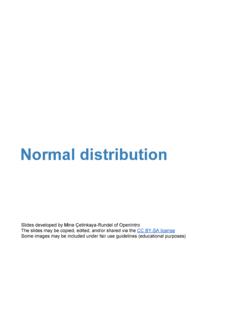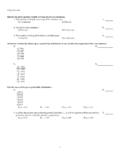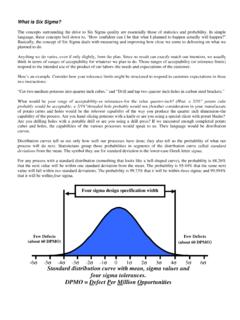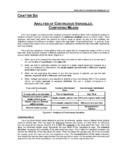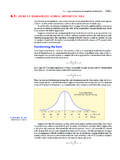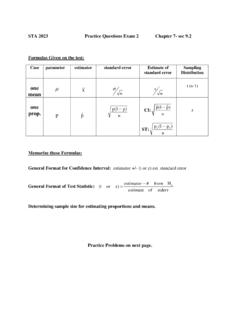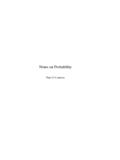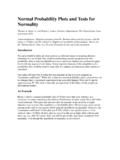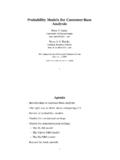Transcription of The Distribution of Stock Returns - Daily Speculations
1 The Distribution of S&P 500 Index Returns William J. Egan, January 6, 2007 Abstract This paper examines the fit of three different statistical distributions to the Returns of the S&P 500 Index from 1950-2005. The normal Distribution is a poor fit to the Daily percentage Returns of the S&P 500. The lognormal Distribution is a poor fit to single period continuously compounded Returns for the S&P 500, which means that future prices are not lognormally distributed. However, sums of continuously compounded Returns are much more normal in their Distribution , as would be expected based on the central limit theorem.
2 The t- Distribution with location/scale parameters is shown to be an excellent fit to the Daily percentage Returns of the S&P 500 Index. Introduction The Distribution of Stock Returns is important for a variety of trading problems. The scientific portion of risk management requires an estimate of the probability of more extreme price changes. The correct Distribution will tell you this. For option traders, the Black-Scholes option pricing model assumes lognormal asset price distributions. For portfolio managers, the Sharpe ratio is based on the mean and standard deviation of differential Returns and is useful for comparing the risk-reward tradeoff of different strategies.
3 The two distributions most commonly used in the analysis of financial asset Returns and prices are the normal Distribution and its cousin the lognormal distributions. In practice, the lognormal Distribution has been found to be a usefully accurate description of the Distribution of prices for many financial normal Distribution is often a good approximation for Returns . [1] The Normal Distribution The normal Distribution is the familiar bell-shaped curve defined by two parameters: the mean and the standard deviation.[2] Figure 1 plots the probability density function (pdf) for an example of the normal Distribution having mean = 0 and standard deviation = 1.
4 The pdf is the probability of x taking a particular value.[3] A useful first step when analyzing the Distribution of a set of data is to plot a histogram. A histogram sorts the data into a specified number of bins and plots the counts of observations falling in each bin.[4] Figure 2 plots a histogram with 500 bins of the Daily percentage changes of the S&P 500 index from 1950-2005 (the S&P 500 data). The histogram has a similar appearance to a normal curve. Is the S&P 500 data normally distributed? A simple way to check this is compare a density histogram to a theoretical normal curve.
5 A density histogram is a histogram normalized so that the area under the bars sums to one (essentially making it into a discrete probability density function). Figure 3 shows a density histogram of the S&P 500 data, with a normal Distribution overlaid. There is a definite lack of overlap. Especially important is the fact that the histogram has a greater density at the extremes than the normal Distribution predicts, which you can see in the bottom part of Figure 3. Another good technique to use when analyzing distributions is the probability plot.[5] In a probability plot, the data is ordered and plotted against its percentage points from a theoretical Distribution .
6 If the plot produces a straight diagonal line, the data is distributed the same as the theoretical Distribution . Figure 4 shows a normal probability plot for the S&P 500 data. The plot is strongly s-shaped indicating that the Daily percentage changes in the S&P 500 are not normally distributed. In contrast, Figure 5 shows a normal probability plot of 1,000 random values drawn from a normal Distribution with mean = 0 and standard deviation = 1. The data points form a straight line indicating they have a normal Distribution . More quantitative measures confirm that the Daily percentage Returns of the S&P 500 data are not normal.
7 [6] Skewness is a measure of lack of symmetry, and deviations from zero indicates the data is spread more to the left or right than in a normal Distribution . Kurtosis is a measure of how peaked the Distribution is and how fat its tails are; positive values indicate heavy tails. The skewness of the S&P 500 data is , indicating a slight negative asymmetry, while the kurtosis is + , indicating their Distribution has heavy tails. The Jarque-Bera test is a statistical hypothesis test that uses the skewness and kurtosis of a data set to test if it is normally distributed.
8 [7] The Jarque-Bera test p-value for the Daily percentage Returns is < indicating it is highly unlikely that this data is normally distributed. Using the normal Distribution to estimate risk for the S&P 500 would be unwise. For the Daily percentage changes of the S&P 500, the mean = + and standard deviation = Daily percentage losses of > 2% are predicted to occur of the time, but actually occur of the time, a 39 % increase. The greater the percentage loss, the greater the discrepancy. From 1950-2005, there were 11 days out of 14090 days where the loss was > 5%, giving an observed incidence rate of The normal Distribution predicts that losses of that magnitude should never happen.
9 The predicted incidence rate is , or about 1 day in 434,211 years. The Lognormal Distribution Now we can move to the interesting lognormal Distribution . If a variable x is lognormally distributed, the natural logarithm of x, ln(x), is normally distributed. A lognormal Distribution is defined by the mean and standard deviation of ln(x). Figure 6 shows an example of a lognormal Distribution . The lognormal Distribution has the property of being bounded at zero, , the natural logarithm of negative numbers is undefined. This is considered a useful property because asset prices do not go below zero.
10 The lognormal Distribution also has a much longer right tail which permits it to fit more extreme values. The continuously compounded return of an asset over a given holding period is defined as ln(ending price/beginning price)..if a Stock s continuously compounded return is normally distributed, then the future Stock price is necessarily lognormally distributed. [1] Figure 7 shows a plot of the 1-day continuously compounded return for the S&P 500 data. There is considerable deviation from linearity indicating that the Daily continuously compounded Returns are not normally distributed.
